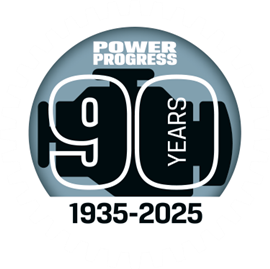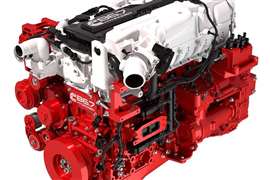Read this article in Français Deutsch Italiano Português Español
Hybrid tech bridges the gap between ICE and all-electric
16 June 2025
Editor’s Note: This article was commissioned by the Engine Technology Forum and published with permission by PowerProgress.com.
The internal combustion engine (ICE) has served as an indispensable power source for on-highway and off-highway vehicles for decades. While the ICE continues to showcase an attitude of sustainability as a standalone provider of vehicle power, it’s also a valued partner for a growing number of hybrid-electric vehicle (HEV) applications.
“Hybrid technologies offer a practical solution for reducing fuel consumption and emissions on many different types of vehicles,” according to Allen Schaeffer, executive director of Engine Technology Forum, a non-profit organization that advocates for ICE, its suppliers and producers of fuels.
Within each major mobility sector — passenger vehicles, commercial trucks and off-highway vehicles — there are ICE veterans, hybrid newcomers and hybrid mavericks.
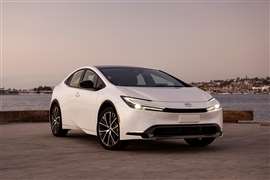 The fifth-generation 2025 Toyota Prius is equipped with the fifth generation of the Toyota Hybrid System (THS). The THS is also used for the Toyota Prius PHEV. (Photo: Toyota)
The fifth-generation 2025 Toyota Prius is equipped with the fifth generation of the Toyota Hybrid System (THS). The THS is also used for the Toyota Prius PHEV. (Photo: Toyota)
Passenger Vehicles
“Toyota has been building hybrid vehicles for more than 25 years and that’s for good reason. We had a drive and a need to reduce carbon emissions on the roads,” said Dante Boutell, vice president of Powertrain Control at Toyota Motor North America in Ann Arbor, Mich.
With the debut of the 1997 Toyota Prius in the Japanese market, the Prius became the world’s first mass-produced hybrid-electric car. The 2025 Prius uses a fifth-generation Toyota Hybrid System (THS). “The first, second and third generations of THS made huge technology leaps,” Boutell said. Other improvements, including reducing the hybrid system’s size and weight, were hallmarks of the fourth and fifth generation product. “We’re working on another generation of THS.”
In 2024, automakers sold more than 12.9 million ICE-powered passenger vehicles in the United States. Hybrid passenger vehicle sales in 2024 topped 1.6 million units, the highest industry-wide U.S. volume to date. Since 2021, hybrid sales have been on an upward trajectory, according to data from the U.S. Department of Transportation Statistics.
That continued uptick in hybrid sales helped usher in an $88 million investment for an additional production line at the Toyota West Virginia assembly plant. The new line will produce next-generation hybrid transaxles for Toyota and Lexus vehicles. Start of production for the driveline system that transfers power seamlessly between the engine, the electric motor and the wheels is slated for late 2026.
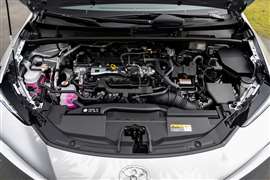 An underhood view of the 2025 Toyota Prius hybrid. (Photo: Toyota)
An underhood view of the 2025 Toyota Prius hybrid. (Photo: Toyota)
Toyota’s multi-pathway approach to electrified vehicles centers on all-electric, hybrid-electric and plug-in hybrid-electric vehicles. PHEVs operate on all-electric only, ICE-only or a hybrid combination of both. Unlike HEVs, PHEVs can be plugged into an external power outlet to recharge the high-voltage batteries.
“In 2023, Toyota’s electrified vehicle sales in the U.S. were 29%. That grew to 43% in 2024, and it’s expected to reach 50% in 2025. So those are big steps between 2023 and 2025,” Boutell said.
Hybrid-electric passenger vehicles have dramatically changed over the years — both in terms of technology and the driving experience. “Twenty-five years ago, hybrids were a little bit quirky to drive. The braking wasn’t as smooth as a non-hybrid. You could sense the engine going on and off, and the acceleration, at times, wasn’t quite enough,” Boutell explained.
The driving experience is much different today. “It’s now a very smooth and comfortable ride and that’s helping with the adoption of hybrid-electric. And with higher volumes, scale comes into play so the cost of a hybrid passenger vehicle isn’t that different from an engine-only powered vehicle,” Boutell said.
Like Toyota and many other passenger vehicle producers, Hyundai’s product lineup features ICE-only and electrified offerings. “Consumers don’t have to sacrifice performance to be more fuel efficient or be more environmentally conscious because with our new hybrid system, you get a lot more horsepower and lower tailpipe emissions than the ICE equivalent,” said John Shon, senior manager for product planning at Hyundai America.
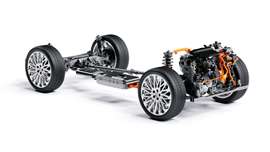 Cutaway view of Hyundai’s next-generation hybrid system, which debuts on the 2026 Palisade SUV. (Photo: Hyundai)
Cutaway view of Hyundai’s next-generation hybrid system, which debuts on the 2026 Palisade SUV. (Photo: Hyundai)
The 2026 Hyundai Palisade with a 2.5 L turbocharged four-cylinder hybrid-electric system is expected to produce an additional 40 hp versus the 2026 Palisade with a 3.5 L V6. “The new hybrid system provides strong fuel economy. On particular vehicle models, that will be 12 to 13 mpg higher, so about a 40% to 50% improvement in fuel economy,” said Shon.
As a large SUV with three seating rows, the 2026 Palisade will be the first model with Hyundai’s next-generation hybrid system. Hyundai has offered hybrid technology in the U.S. since 2012 when the Sonata midsize sedan debuted the automaker’s first-generation hybrid technology. “For the Palisade we wanted a more robust hybrid system, so this second-generation system adds a second electric motor to evolve and improve the hybrid system,” said Shon.
Commercial Trucks
For the 2025 model year, Isuzu Commercial Truck of America, Inc. debuted its first full-electric vehicle. In addition to the all-electric NRR-EV medium-duty truck, Isuzu’s offerings in the U.S. are ICE-powered commercial trucks using gasoline (N-Series light heavy-duty trucks) or diesel fuel (N-Series light heavy-duty trucks and F-Series medium heavy-duty trucks).
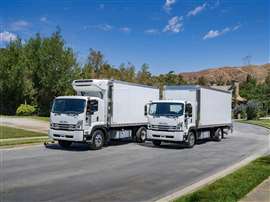 Isuzu F-Series commercial vehicle models. (Photo: Isuzu)
Isuzu F-Series commercial vehicle models. (Photo: Isuzu)
Power options matter to customers. “A lot depends on the truck’s application, so we have customers who are looking at just electrification and other customers who are looking only at conventional ICE. And, there are customers who want both — pure electric and pure ICE — in their fleet,” said Jeff Marsee, executive director of the Isuzu Technical Center of America in Plymouth, Mich.
Today’s ICE-powered Isuzu trucks in the U.S. meet the current U.S. Environmental Protection Agency (EPA) NOx requirements of 200 mg NOx. “Our company is working diligently to be compliant for 2027 and later years with the new low-NOx EPA standards for the 50 states,” said Marsee. Ongoing development work centers on a future engine primarily used for Class 4 and 5 light heavy-duty trucks. “We’re looking for our low NOx engine to achieve an 80% greater reduction from the current NOx standard,” Marsee said.
Beyond meeting governmental emissions requirements, customer demand played a role in the engine’s development. “We have customers who want to be more environmentally friendly, and they also want better fuel economy and better total cost of ownership,” said Marsee. Although the under-development engine is diesel-focused now, “the long-term plan would be a multi-fuel application,” Marsee said.
Cummins engineers are working on two diesel engines for medium-duty trucks. The engines use Cummins’ HELM (high-efficiency, low emissions) engine strategy.
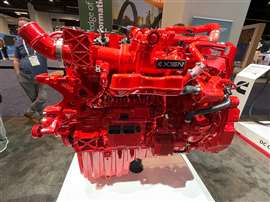 The 15 L X15N natural gas engine was Cummins’ first production engine to employ the HELM platform. (Photo: Becky Schultz)
The 15 L X15N natural gas engine was Cummins’ first production engine to employ the HELM platform. (Photo: Becky Schultz)
“The new 7.2 L and 10 L diesel engines will have similar or better performance for horsepower and torque than the current engines. The engines will also have a significant reduction in GHG (greenhouse gas) emissions and better fuel economy than the current engines,” said Jim Nebergall, executive director of Market Strategy for Cummins Inc. Both engines will reach the market in 2027, coinciding with new EPA emissions rules for medium-duty and heavy-duty trucks.
The HELM strategy underscores flexibility. “Our engines could be diesel — which is the first fuel choice in most cases around the globe — or gaseous fuels, like natural gas or hydrogen,” Nebergall said.
A 15 L natural gas engine, the X15N, was Cummins’ first production engine to employ the HELM platform. “We’re very excited about that engine because it’s the first truly natural gas engine that performs like a diesel engine. It can handle the weights that are common with heavy-duty long-haul trucking,” said Nebergall. The X15N natural gas engine debuted in 2024, and a 15 L diesel engine arrives in 2027.
Off-Highway Vehicles
“The most difficult sector to electrify — either hybrid or full electric — is off-highway, and that’s just because of the power demands of the equipment in an off-highway space relative to the power demands of an on-highway vehicle or over-the-road truck,” said Nick Block, director of Global Marketing & Sales for John Deere Power Systems.
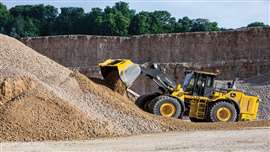 John Deere’s 744 X-Tier handles tasks at a quarry and aggregates site. (Photo: John Deere)
John Deere’s 744 X-Tier handles tasks at a quarry and aggregates site. (Photo: John Deere)
Off-highway vehicles that need 130+ hp to obtain optimum performance are ideal candidates for hybridization, according to Block. Large tractors, combines and sprayers are examples of vehicles using at least 130 hp for agriculture purposes. In construction, the 130-hp or higher vehicle examples include wheel loaders and graders.
“Based on current battery technology, we believe that off-highway vehicles below 130 hp can be fully electrified effectively,” said Block.
John Deere’s hybrid-electric 850 X-Tier dozer arrived at dealerships in North America, Europe and Asia in early 2025. Also in 2025, Africa became the first market with John Deere’s 744 X-Tier hybrid-electric wheel loader.
“Depending on the region of the world and the customer’s needs, we offer machines with an ICE that run on diesel fuel, and we offer machines using ICE with a hybrid system,” said Block. Full battery-electric John Deere tractors are slated to reach the marketplace in 2026.
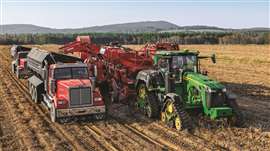 The John Deere 8RX tractor is fitted with the eAutoPowr Electric Variable Transmission to provide up to 100 kW of off-board electrical power via an eDrive Kit. It is installed on this Sputnik potato harvester. (Photo: John Deere)
The John Deere 8RX tractor is fitted with the eAutoPowr Electric Variable Transmission to provide up to 100 kW of off-board electrical power via an eDrive Kit. It is installed on this Sputnik potato harvester. (Photo: John Deere)
Off-board power is another viable venue for hybrid power, according to Block. The process involves creating energy onboard the vehicle for off-board usage. For instance, power produced by an agricultural tractor’s engine can be off-boarded to supply electricity to an agricultural implement, like an attached harvester. “The onboard power provides the ability to drive accuracy, precision and better control of the implement or auxiliary systems that are off-board,” Block said.
A new Caterpillar-developed system transfers energy to large electrified vehicles working at a mining site. “You can have machine inter-operability with the Dynamic Energy Transfer (DET) solution, so you could run a diesel-electric, a battery-electric or even a hybrid-electric truck with the system,” said Krishna Kumar, technical director of Electrification and Energy Solutions Division at Caterpillar. The system is currently being trial tested by Caterpillar at various sites.
The innovative DET system integrates key elements, including a power module that converts energy from a mine site’s power source, an electrified rail system to transmit the energy and a machine system to transfer the energy to a mining truck’s powertrain. DET’s infrastructure can be customized to meet individual mining site layouts.
In addition to the DET system, Caterpillar’s product offerings include trucks powered by diesel-electric as well as battery-electric, such as the zero-emission R1700XE underground loader. Virtually every off-highway application has unique duty cycle and performance demands.
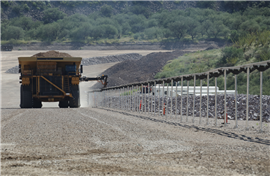 Caterpillar’s Dynamic Energy Transfer system shown at a Caterpillar demonstration site. (Photo: Caterpillar)
Caterpillar’s Dynamic Energy Transfer system shown at a Caterpillar demonstration site. (Photo: Caterpillar)
“The key takeaway is Caterpillar has a range of solutions for our customers. It’s not a one-size fits all power solution,” said Kumar, stressing that the ICE as a primary or a secondary onboard power source “does still exist for some of our solutions, like the diesel-electric and hybrid-electric powertrains.”
With the vast majority of today’s off-highway vehicles powered by diesel engines, fuel plays a vital role in reducing unwanted emissions. In the U.S., current off-highway engine EPA Tier 4 standards limit the amount of harmful exhaust emissions, particularly particulate matter (PM), nitrogen oxides (NOx) and sulfur. Even though ultra-low sulfur diesel is the only fuel required for use in diesel engines via Tier 4 off-highway regulations, alternative fuels derived from sustainable or renewable resources are an option.
“Our current diesel engines are also capable of using biofuels/biodiesel, HVO (hydrotreated vegetable oil) fuel or other alternative fuels,” said Tanner Crook, assistant manager in the application engineering group for power solutions at Yanmar America Corporation. As a producer of diesel engines for the agriculture, construction and marine sectors for more than 90 years, Yanmar is now also developing hybrid-electric solutions.
“We’re starting to see a ramp-up with interest in hybrid and greener technologies,” Crook said, referencing ongoing projects for the off-highway sectors in North America. It is possible that future EPA mandates will further limit the amount of NOx and PM emissions. If CARB proposes further amendments to its off-highway emissions standards, the initial phase-in timeline for those mandates could begin as early as 2029.
Outlook for ICE and HEV
Yanmar is making waves with its early 2025 announcement of a pleasure boat hybrid-electric concept. Project engineers took an existing Yanmar-developed engine and created a hybrid system by adding a lithium-ion battery pack, an electric motor and an inverter. One takeaway is the boat’s power system can run, if desired, on just electric motor propulsion for zero exhaust emissions.
“Yanmar’s YF12e hybrid system signals a transformative shift in marine propulsion blending clean electric mobility with traditional diesel reliability to redefine comfort and sustainability on the water,” said Crook, who wasn’t directly involved with the hybrid project. “ He added, “As part of Yanmar’s wider commitment to decarbonization across all product domains, this innovation lays the groundwork for a future where hybrid and electric technologies are standard in both recreational and commercial marine sectors.”
 The Cummins 6.7 L hydrogen ICE will be the power source for a fleet of Tata Motors tractor-trailers traveling regional routes. Shown is the Tata Prima H.55S. (Photo: Reuters/Rahul Singh)
The Cummins 6.7 L hydrogen ICE will be the power source for a fleet of Tata Motors tractor-trailers traveling regional routes. Shown is the Tata Prima H.55S. (Photo: Reuters/Rahul Singh)
Hydrogen grabbed a large spotlight via Project Brunel. Match-funded by the UK government, the multi-year project concluded in March 2025 with Cummins and technology collaborators developing a 6.7 L hydrogen ICE. “That engine is the cornerstone of a project that will start later this summer in India,” said Cummins’ Nebergall.
The 6.7 L hydrogen ICE will be the power source for a fleet of Tata Motors tractor-trailers traveling regional routes. “This 6.7 L engine meets the performance and speed expectations to drive heavy-duty tractor-trailers on interstate highways in India,” Nebergall said.
India’s government is supporting the project with grant money. “Hydrogen is a zero-carbon fuel, so there’s no carbon coming from the truck’s tailpipe,” said Nebergall, adding that “India is very interested in hydrogen fuel for energy independence and carbon reduction.”
Information gleaned from the India project will have a ripple effect around the globe. “We’re in the early stages, but we expect to scale our learnings to different markets as those markets mature with hydrogen infrastructure,” said Nebergall.
Passenger vehicle industry insiders consider hybrid a bridge technology to full electric. “That bridge, from my perspective, is getting longer. So even though it’s considered a bridge technology, it’s going to be around for a long time,” said Toyota’s Boutell.
Whether it’s hybrid technology applied to very small cars or very affordable cars, or hybrid technology paired with a turbocharged engine or a flexible-fuel engine or a hydrogen-fueled engine, “some sort of hybrid technology is going to exist for decades,” Boutell predicted.
POWER SOURCING GUIDE
The trusted reference and buyer’s guide for 83 years
The original “desktop search engine,” guiding nearly 10,000 users in more than 90 countries it is the primary reference for specifications and details on all the components that go into engine systems.
Visit Now
STAY CONNECTED




Receive the information you need when you need it through our world-leading magazines, newsletters and daily briefings.
CONNECT WITH THE TEAM







